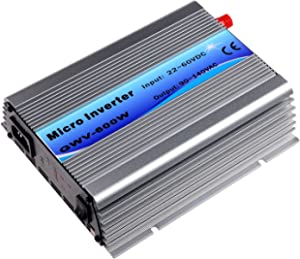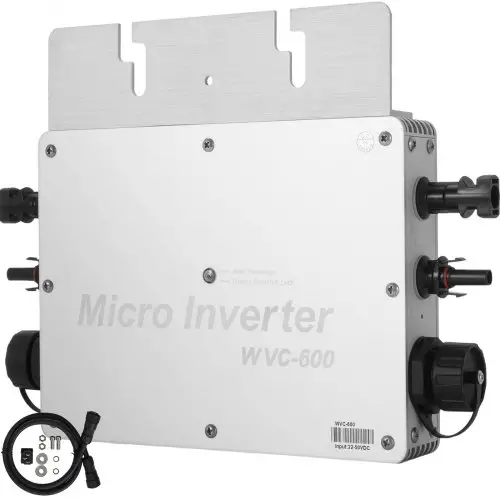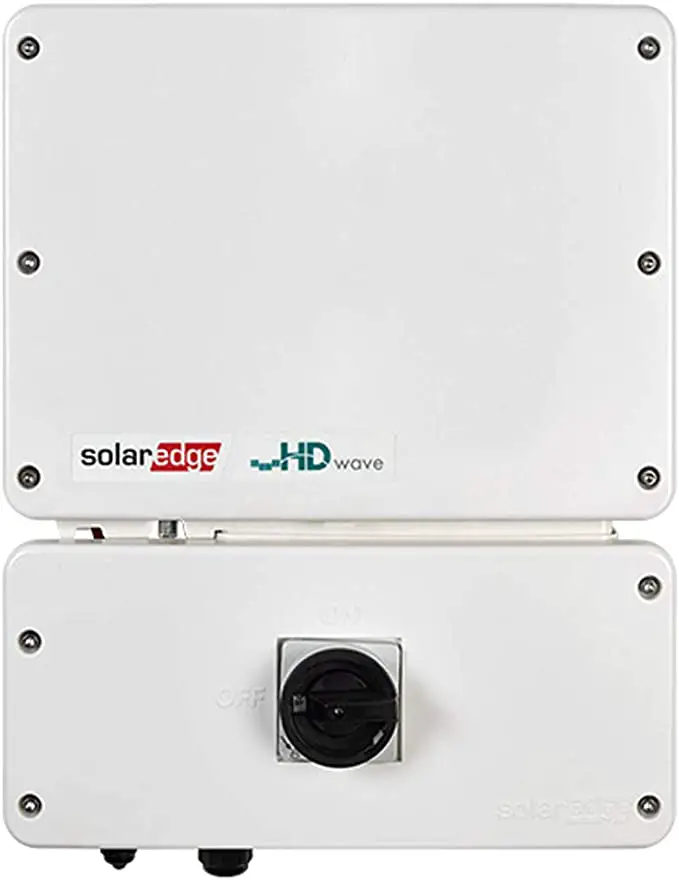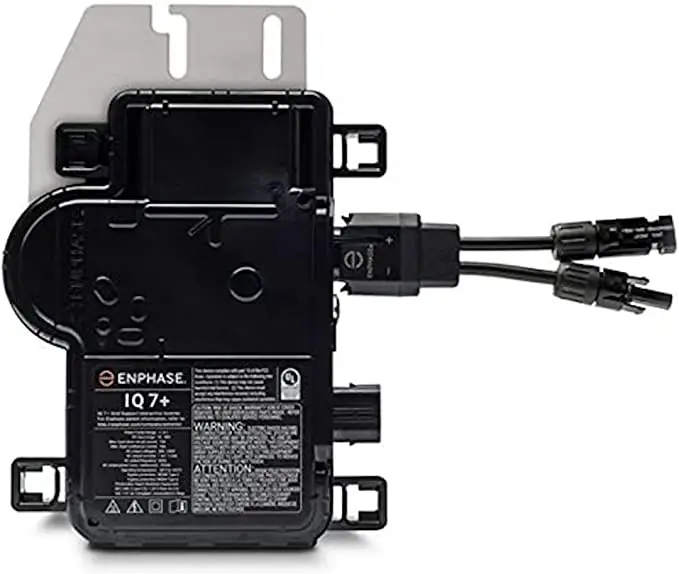In this short buyer’s guide, we’ll show you to 4 best solar grid-tied inverters on the market while talking about Wattage, ease of installation, the laws regarding inverter usage, and efficiency and answering frequently asked questions about grid-tied inverters. Let’s go right into it!
Our Best Picks
Y&H GRID TIE INVERTER 600W

Why did we choose this one? This solar grid-tied inverter goes great with 12V solar panels and 24V batteries. Not only is it easy to install and use, but it is also stackable, so depending on how much power you want from either the electrical grid or solar panels, you can buy more of the identical inverters and stack them for higher efficiency.
What are other users saying about this product?
MPPT technology: Creative MPPT tech makes efficiency higher than 99%! For comparison, the average conversion rate of solar panels is about 75-80%, and for grid-tied inverters, it’s 80-90%.
Multiple protections: The inverter comes with different protections, including islanding, short-circuit, converse connection, low voltage, over-voltage, and over-temperature.
Fan cooling: Intelligence fan cooling technology kicks in when temperatures of the area of the inverter get above 110° F. High-speed ventilation fans help keep the inverter running at low temperatures.
VEVOR SOLAR GRID TIE Micro INVERTER

Why did we choose this one? The VEVOR 600W inverter is perfect for a 600 Watt solar system. There is also a 1200 Watt option available in the VEVOR store. With high efficiency of 99.9% and a standby power consumption of less than 1 Watt, you won’t be able to find a better solar grid-tied inverter for your 600W system.
What are other users saying about this product?
Stays cool: With the fan running most of the time to cool the solar inverter, the inverter maintains a low temperature, making the device produce electricity efficiently and quietly.
Great for Outdoors: IP65 waterproof design and aluminum alloy material can effectively prevent rainwater erosion on the surface. It provides electrical isolation, more reliable to use
Multiple features: The inverter features MPPT technology with over-current, over-temperature, reverse polarity, and island protection—the device is also stackable!
SOLAREDGE SINGLE PHASE 5000-WATT GRID-TIED INVERTER

Why did we choose this one? The SolarEdge single-phase inverter with HD-Wave technology breaks the mold of traditional solar inverters. The record-breaking 99.2% efficiency allows more energy production for an improved return-on-investment, which means that you’ll be able to make your money back faster.
What are other users saying about this product?
Highly efficient: With up to 155% oversizing allowed, there’s high reliability for this inverter due to its lower heat dissipation.
Extended warranty: There is a standard 12-year warranty extending to 20 or 25 years if needed. This makes the inverter a great purchase due to its long-lasting life.
Wireless features: This inverter features internet communication via Ethernet or wireless connectivity using optional ZigBee or cellular plug-ins. With NEMA 4X, this inverter is also suitable for outdoor and indoor installations.
ENPHASE IQ7PLUS-72-2-US MICROINVERTER

Why did we choose this one? The Enphase IQ 7+ microinverter dramatically simplifies the installation process while achieving the highest system efficiency. With the microinverter, you also receive the Enphase Enlighten monitoring and analysis software to ensure you’re completely up-to-date with all of the newest features and updates.
What are other users saying about this product?
Easy to install: This microinverter is lightweight and straightforward, leading to a faster installation with improved, lighter two-wire cabling. There’s also a built-in rapid shutdown compliant which makes your life less stressful.
Productive and reliable: Optimized for high-powered 60-cell and 72-cell solar modules, this solar microinverter has been tested for over a million hours to improve reliability.
Protected with durability: The microinverter is listed as a product containing a class II double-insulated enclosure and UL listed for improved productivity and durability.
FACTORS REGARDING INVERTERS
Picking the right solar grid-tied inverter requires a lot of factors, steps, and yes-no’s before purchasing. Even though most grid-tied inverters cost anywhere from $50-$250, it’s still a lot of money on top of the solar system kit that’s purchased. Let’s discuss some of those factors.
Laws Regarding Solar Usage
Since solar power is beginning to become more affordable, and more people are switching to solar power rather than the city’s electrical grid, electric companies are losing money more rapidly. Because of this variable, electric companies have started charging a “minimum usage charge.”
For example, if the minimum usage charge for your state is $75, and you used up $125 worth of electricity, you just simply pay the $125 electrical charge. However, because of solar power, if your electrical charge is $60, you’ll still need to pay the difference and pay a total of $75.
This is unfair to many, but different states have their own rules. Be sure to check with your state about solar power laws.
Wattage
For an inverter to be right for your solar system, its Wattage rating must be about the same as your solar system’s Wattage rating—this is the correct way to appropriately size a solar inverter.
For example, if your solar system is rated at 1,000 Watts, you’ll need a solar inverter with about 1,000 Watts—if it isn’t possible to have a 1,000 Watt solar inverter, always go for a rating above the recommended amount, as more is better than less.
Peak Efficiency
For average solar inverters, the peak efficiency is normally between 94-96% because cable losses are lower due to the power being transported around the solar system as AC power rather than DC. Premium inverters can be as high as 99% with microinverters usually going up to 96%.
Ease of Installation
Several years ago, solar inverters used to be large and inaccessible, but in 2021, most solar inverters are as small as a gaming console—maybe even smaller. Installing most solar inverters are way easier than it used to be.
Following the guide that the solar inverter comes with will be just enough for you to easily install the inverter in the right spot without any professional help. Getting a low quality, off-brand solar inverter isn’t necessarily a bad idea, but just know that if you run into trouble installing the device, you won’t be able to properly ask for help online in most of the cases.
FREQUENTLY ASKED QUESTIONS
With grid-tied solar inverters, there come many commonly asked questions. In this guide, let’s answer some of the most frequently asked ones!
Do grid-tied inverters influence which battery to use?
Grid-tied inverters don’t influence a battery as much as how much solar batteries influence grid-tied inverters. An inverter should be decided based on the settings, Wattage, and Voltage of the solar battery. For example, if a solar battery you have is rated at 12 Volts, then the grid-tied inverter you should purchase is recommended to be a 12V solar inverter.
What is the difference between grid-tied and off-grid inverters?
An off-grid inverter is used in cases where all of your power comes from solar power. A grid-tied should be used when most of your power comes from solar panels and the rest from the city’s electrical grid.
An off-grid inverter directs power from your solar panel to your solar batteries to be used to power appliances. A grid-tied inverter redirects electricity from solar panels to a solar battery as well but first through a meter that keeps tabs on how much power there is within the solar panels. Once the solar battery falls below a certain level, the city’s electrical grid will kick in and power your appliances until more power is received.
Can a grid-tied inverter be used off the grid?
A grid-tied inverter can be used off the grid, but there’s no guarantee about its efficiency since it isn’t meant to run fully off-grid. You must have a premium or a high-quality solar grid-tied inverter to be used off the grid.
Does Voltage rating matter with an inverter?
Yes, Voltage rating matters with an inverter. You must take into consideration what your solar panels are rated at along with your solar batteries and the rest of your system. If you’re unsure about the appropriate ratings or compatibility, there are always ways to search up what inverters are best with what systems—they should also be specified in most inverter guides, most of the time.
What is defined as usable AC power?
When electricity comes from solar panels to a solar inverter, it is in direct current, or DC—this isn’t usable in most appliances, so a solar inverter is needed to invert the current from DC to AC, or alternating current. AC power is electricity that can be stored and used with almost every household appliances.
Can you stack multiple inverters together?
Yes, you can stack multiple inverters together! In some cases, it is widely recommended that you stack inverters together in case of an absence of power inversion. This should only occur with inverters of the same kind or from the same company, as stacking inverters can be tricky at times.
What is net metering?
Net metering can be described almost as a way to sell your electricity that you produce from solar power. When you generate electricity through solar power, you sometimes can have a surplus of electricity that isn’t being used by your house’s appliances—you can sell this leftover energy and provide it to the city’s electrical grid.
From the leftover energy, you can receive tax credits given for solar power that could help reduce annual tax bills and lowering your monthly utility bills as a way for the government and the city to thank you.
WRAPPING UP
Hopefully, this guide helped you better understand what grid-tied inverters are, where to buy the best ones, and what factors to look for when purchasing the right one for your solar system.
Even though it’s relatively cheaper than most components of a solar system, you should still know where your money is going and how well it’s being spent!
